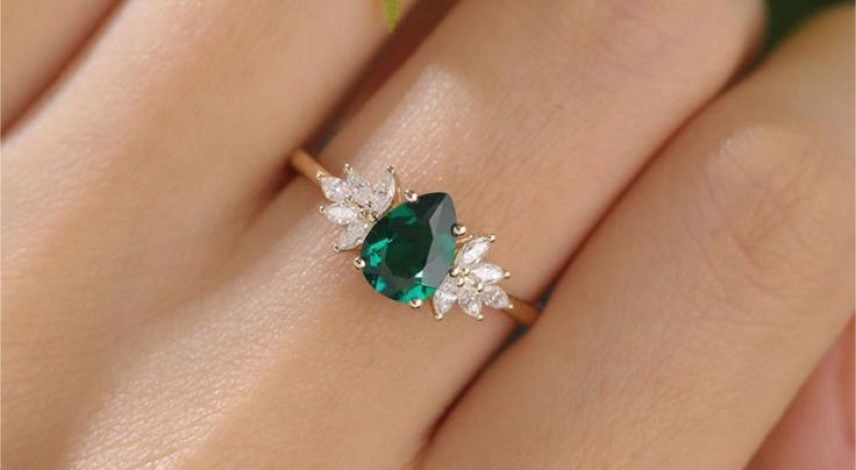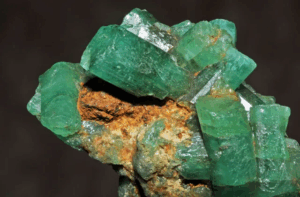What’s May’s Birthstone?
0 comments
SHOP BY STYLE ✧
SHOP BY SHAPE ✧
![]()
![]()
![]()
![]()
![]()
METAL COLOR ✧
WEDDING BANDS
SHOP BY STYLE ✧
![]()
![]()
![]()
SHOP BY STONE ✧
SHOP BY METAL ✧
JEWELRY FOR THE BIG DAY
NECKLACES ✧
EARRINGS ✧
BRACELETS ✧
Engagement ✧
SHOP BY SHAPE ✧
![]()
![]()
![]()
![]()
![]()
![]()
SHOP BY COLOR ✧
SHOP BY CATEGORY✧

FEATURED✧
SHOP BY CATEGORY✧
SHOP BY OCCASION✧
SHOP BY PRICE✧

Birthstone Jewelry

From ancient traditions to modern style, birthstones are more than mere gemstones – they are personal emblems infused with meaning and memory. Each birthstone carries a legacy of stories and emotions, connecting us to generations past and reflecting our own journey. These storied gems hold a timeless appeal, serving as symbols of identity and celebration for those who wear them.
As spring awakens each year, nature’s rebirth mirrors the spirit of May. This month’s birthstone, the emerald, captures the essence of fresh growth and enduring beauty. Its lush green hue evokes the world coming alive – the soft rustle of new leaves, the warm caress of sunshine on dewy grass. In the same way, an emerald gemstone can feel like a piece of spring itself, carrying a promise of renewal and hope.
May’s birthstone is the emerald: a gem prized for its vibrant green color and timeless elegance. Imagine the rich, deep green of emeralds, the color of a sun-dappled forest or the velvety shade of a spring meadow. This brilliant hue, born of trace chromium and vanadium within the crystal, gives emeralds their instantly recognizable glow. As a variety of the beryl mineral family, emerald is hard enough for fine jewelry (around 7.5–8 on the Mohs scale) yet it often contains tiny natural inclusions. Gem experts affectionately describe these as the stone’s “jardin” (garden), a delicate tapestry of nature that adds charm and authenticity to every emerald, making each gem one-of-a-kind.
Emerald has long been associated with prestige and refinement. Celebrated by royalty and visionaries through the ages, it was treasured by the likes of Cleopatra and other historical figures who adored its lush color and aura of mystery. Today, this precious green gem remains beloved among those who appreciate both classic luxury and modern style. Its deep green tone pairs beautifully with warm gold or cool platinum, and it complements both vintage-inspired and contemporary designs. Worn in a simple pendant or a bold statement ring, an emerald always carries a sense of elegance and renewal that endures far beyond the spring in which it blooms.
Emeralds have captivated civilizations for thousands of years. One of the earliest known sources of emeralds was ancient Egypt, where they were mined as early as 330 BC. Cleopatra, the legendary queen of Egypt, was famously passionate about emeralds. She adorned herself with them, gifted them to foreign dignitaries, and even claimed ownership of the country’s emerald mines. For the Egyptians, emeralds symbolized fertility, rebirth, and protection in the afterlife.
The allure of emeralds didn’t stop in Egypt. In ancient Rome, emeralds were associated with Venus, the goddess of love and beauty, and were believed to promote fertility and loyalty. Roman scholars also believed that gazing into an emerald could soothe the eyes and calm the mind—a sentiment that persisted through the Middle Ages.
In South America, the Muzo people of what is now Colombia treasured emeralds long before the Spanish conquest. When the Spanish arrived in the 16th century, they were astonished by the abundance and quality of emeralds in the region. These Colombian emeralds soon made their way into the treasuries of European monarchs, sparking a global fascination that continues today.
Across cultures and centuries, emeralds have stood for love, renewal, clarity, and eternal life. Their deep green color connects them symbolically with nature, growth, and the heart chakra in spiritual traditions. Whether worn as amulets or royal adornments, emeralds have always conveyed prestige and deeper meaning.
These natural beryl (Be₃Al₂(SiO₃)₆) crystals grow in a six-sided prismatic shape; trace amounts of chromium and vanadium in the crystal lattice give the stone its rich green color. Emeralds are the green variety of beryl, whose chemical formula is Be₃Al₂(SiO₃)₆. In pure beryl the stone would be colorless; emerald’s signature green comes from tiny amounts of chromium (Cr³⁺) and sometimes vanadium (V³⁺) replacing some of the aluminum in the crystal structure. This substitution alters the way the crystal absorbs light, yielding an intense green hue. Each emerald crystal forms in a hexagonal (six-sided) prism shape, as seen in the photo. The hexagonal beryl framework gives emerald a hardness of about 7.5–8 on the Mohs scale, making it sturdy enough for fine jewelry (though natural cleavages and inclusions make it more prone to chipping than harder gems like diamond).

Emeralds grow under very specific geological conditions. Typically, beryllium-rich, silica-laden fluids (often related to granitic magma or hydrothermal activity) percolate through chromium- or vanadium-bearing host rocks (for example ultramafic rocks or black shales). When these fluids cool slowly in veins or pegmatites, emerald crystals can form over millions of years. Tectonic uplift and erosion eventually expose the emerald-bearing rock to the surface. Famous sources include Colombia’s Muzo and Chivor mines, which have produced some of the world’s finest, vividly green emeralds. Other major deposits are found in Brazil, Zambia and Zimbabwe. Stones from different localities often carry subtly different hues (for example, Colombian emeralds tend to be pure green with a slight bluish tone), but all share the same beryl chemistry and hexagonal crystal structure.
Gemologists evaluate every fine emerald by the Four Cs: Color, Clarity, Cut and Carat weight. Each of these factors is important, but emeralds have special standards compared to other gems. Below is how the Four Cs apply to emeralds:
Today’s gemological reports often note an emerald’s origin and any clarity treatments. Colombia remains the traditional benchmark for fine emeralds: stones from Muzo or Coscuez are famed for their deep green tones. Zambia, Brazil and other sources each produce emeralds with characteristic hues (for example, Zambian emeralds often have a bluish cast). Because almost all emeralds have natural fissures, gem labs indicate whether an emerald has been clarity-enhanced. In practice, most emeralds are oiled or resin-filled to improve transparency, and this is accepted industry practice. These disclosures allow buyers to understand a gem’s true quality. Ultimately, the Four Cs (particularly color and clarity) – considered alongside origin and treatment – determine the beauty and value of an emerald in high-end jewelry.
Wearing an emerald is more than just a style choice—it’s a personal statement rich with emotional and symbolic meaning. Traditionally, emeralds are believed to bring wisdom, growth, harmony, and protection. Their connection to the heart chakra makes them a symbol of love, compassion, and emotional balance.
Emeralds are often gifted as meaningful tokens to celebrate life’s most important moments. As the birthstone of May, they make a thoughtful birthday gift for anyone born during this month. But their appeal goes beyond birth dates. Here are some ideal occasions to give (or wear) an emerald:
Fashion-wise, emeralds are incredibly versatile. Their rich green hue complements both warm and cool skin tones and pairs elegantly with gold, silver, or platinum settings. Whether set in a minimalist pendant or a statement cocktail ring, emerald jewelry adds a luxurious, timeless touch to any outfit.
For those interested in energy and healing properties, emeralds are believed to encourage emotional clarity, creativity, and inner peace—making them a favorite among crystal enthusiasts as well.
The emerald isn’t just the birthstone for May—it’s a gem that has enchanted humanity for millennia with its breathtaking beauty and powerful symbolism. From Cleopatra’s treasures to modern-day heirlooms, emeralds have remained a symbol of love, vitality, and spiritual depth.
Whether you’re celebrating a birthday, honoring a loved one, or simply drawn to the lush green glow of this iconic stone, wearing an emerald connects you to a tradition as rich and enduring as the gem itself.
Let the emerald remind you of renewal, beauty, and strength—not just in May, but all year round.